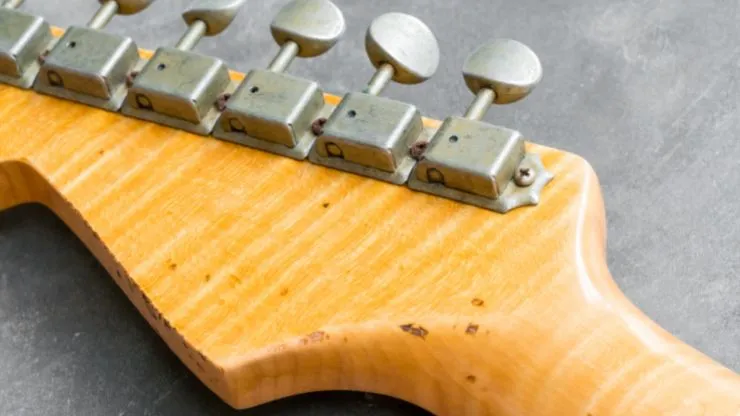One of the classic tonewoods, it’s been used more in manufacturing guitars than virtually any other wood. But why is maple such a popular tonewood? In this article, we’ll tell you everything you need to know.
What Is Maple?
Acer trees, more commonly known as maples, belong to the Sapindacae genus. There are approximately 130 maple species, of which all but one is native to the Northern Hemisphere. While they are common in Europe, North America, and North Africa, most maple species are native to Asia, especially China.
Aside from its palmate leaves and tasty syrup, maple is also famous for its popular timber, which has a variety of uses, including hard-wearing flooring, bowling alley lanes, furniture, cabinetry, and musical instruments.
What Are the Pros and Cons of Maple Guitars?
| Pros | Cons |
|---|---|
| Great projection | Soft maple used in guitar bodies isn’t as durable as some options |
| Bright tone | Detailed figured finishes can be costly |
| Excellent clarity and note separation | The brighter colour and finished nature of maple fretboards aren’t to everyone’s tastes |
| A choice of incredible figured finishes | |
| Durable (in general) |
Maple Varieties
While guitar makers don’t use anywhere near all 130+ species of maple, there are a few different ones that you might stumble across:
Black Maple (Acer nigrum)
Black maple is one of the favourite maples of luthiers owing to its relative ease of workability and good physical properties. It has a Janka hardness rating of around 1,180 and offers good projection and a tight, bright, and well-balanced tone.
Silver Maple (Acer saccharinum)
Also known as soft maple, Silver maple is quite a lot softer than black maple (Janka score of 700), which means it is less durable, but also a little easier to work with. Tonally, it doesn’t have quite the projection or low-end tightness that black maple offers, but it does have good clarity and note separation.
Red Maple (Acer rubrum)
Also considered a soft maple, red maple has a Janka score of 950, putting it right between black and silver maple in terms of hardness. As one of the most common trees in North America, red maple is very popular with independent American luthiers. However, few big guitar brands claim to use it in their productions.
Rock Maple (Acer saccharum)
Rock maple is also known as sugar maple or hard maple. Like some other maple species, it’s relatively unique in that woodworkers usually use the tree’s sapwood for lumber, not its heartwood, as with most other trees. This use of sapwood gives us some of the fantastic, aesthetically pleasing figured finishes associated with maple guitar tops (more on that later). With a Janka score of 1,450, it has good hardness, which gives it excellent projection, a tight tone, and good durability.
European Maple (Acer pseudoplatanus)
When it comes to its wood, European, or sycamore, maple is, in many ways, a European version of red maple. It’s one of Europe’s most widespread maple trees, especially in the U.K., yet guitar makers rarely use it. Sycamore maple has a similar Janka score (1050) to red maple, and it’s known for having good density and stiffness, with a well-balanced tone and nice clarity.
Maple Tonewood Appearance
Aside from its awesome tonal qualities and outstanding physical characteristics, one of the biggest attractions to maple tonewood is its appearance. Because woodworkers use the sapwood and not the heartwood of most maple trees, the wood will often have imperfections due to rotting, insect attacks, and fungal or bacterial infection. However, these imperfections can give the maple remarkable aesthetic properties with the following figure patterns:
Birdseye
Birdseye maple is one of the rarer figure patterns and is typically found in hard maples. Interestingly no one is exactly sure what causes birdseye maple. Theories include climate change, genetic mutation, and birds pecking the wood!
Curly
Also known as flamed or tiger maple, curly figures are more common in soft maple trees. They feature curled grain patterns caused by distorted wood fibres.
Quilted
Often seen in soft maples, such as bigleaf maple, quilted maple has an incredible wavy pattern caused by ageing and the tree’s genetics.
Spalted
Spalting can occur in most species of maple. Rather than being a specific type of maple, spalted maple is wood from a tree allowed to decay partially, resulting in fungal discolouration.
Ambrosia
As with spalted maple, ambrosia maple is wood that has suffered fungal decay. However, in this case, the fungus results from wood-burrowing ambrosia beetles invading the tree. Ambrosia maple is more common in soft maple species.
Why Is Maple a Good Guitar Tonewood?
Maple is a tried-and-tested tonewood that has developed a reputation as one of the top choices for any number of functions. Its great range of physical properties, excellent tone, attractive finish, sustainability, and relative ease of working means it is the first choice tonewood of many luthiers.
How Is Maple Used in Guitars?
Maybe the question should be, how isn’t maple used in guitars?! With good stability and resistance, as well as being dense but responsive to bending and shaping, maple is an excellent choice for the back and sides of acoustic guitars. Similarly, it is popular for body tops in acoustic and electric guitars thanks to its superb clarity, projection, brightness, and often stunning appearance.
Maple is also one of the most popular options for guitar necks. With its good strength, stability, bright tone and excellent clarity, many luthiers regard maple as the best wood choice for guitar necks. And to top things off, maple can also be a terrific choice for fretboards too. While many people may prefer the dark aesthetics of a rosewood or walnut fretboard, the hardness and brightness of certain maple species means that maple fretboards certainly have their advantages.
Are Maple Guitars Durable?
The durability of maple depends on the type of maple the guitar is built from. Maple can have a Janka score of anywhere from 700 – 1450, depending on whether it’s a soft or hard maple species. But, if you have a guitar with a maple neck or fretboard, you can guarantee that durable hard maple, such as rock maple, has been used in its construction. This will give your neck good stability and resistance to damage. Guitar makers only really use soft maple in guitar bodies, so the worst-case scenario usually is a few minor dints – and you can even mitigate that by keeping your guitar in a protective case when not in use.
Maple Guitar Maintenance
One of the benefits of maple fretboards is that they nearly always have a nitrocellulose lacquer finish. The beauty of a finished fretboard is that, unlike raw versions, such as rosewood ones, you don’t need to oil your fretboard. You can clean your frets using a slightly damp or dry microfibre cloth.
Don’t be tempted to use #0000 steel wool or lemon oil on your finished maple fretboard, or you may scuff the coating or take its sheen off. Other than that? Clean a maple guitar just like you would any other:
- Keep your guitar at a stable temperature and humidity.
- Clean with a good quality polish.
- Dust with a non-abrasive microfibre cloth.
- Store in a padded case whenever you aren’t strumming.
Is Maple Sustainable?
Given its widespread distribution and numerous species, maple is a very sustainable wood with no concerns for its future. No species that guitar makers commonly use appears in the CITES Appendices or on the IUCN Red List.
Maple Tonewood Alternatives
If you’re looking for less brightness and more warmth or resonance, then mahogany is an excellent alternative. On the other hand, for a more dynamic, scooped sound with incredible highs and lows, think rosewood.
If you prefer your fretboards on the darker side, then walnut could be for you. Or maybe one of the great sustainable alternatives to rosewood, such as pau ferro or ovangkol.
Finding Your Maple Guitar
If you’re ready to take the plunge on a maple guitar, it’s time to head over to our Finder tool! Simply select your requirements, including body type, price range, and wood, and start looking for your perfect maple guitar.

